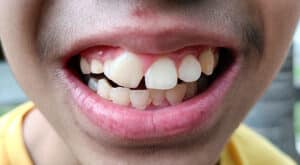When it comes to parenting, the choices we make for our little ones are often scrutinized, and myths surrounding various aspects abound. One prominent worry is the usage of pacifiers and their suspected link to the development of buck teeth in children. Do pacifiers cause buck teeth?
What makes this subject important? Well, incorrect information might cause you to fret or ignore your child’s dental development, which is important for their general health. Then, with an objective eye, let’s examine the pacifier-buck tooth relationship and sort out the real worries from the baseless ones.
Understanding Buck Teeth
Buck teeth, scientifically known as malocclusion or protruding front teeth, refer to a dental condition where the upper front teeth noticeably extend beyond the lower front teeth when the jaws are closed.
The Pacifier Debate
Pacifiers, also known as binkies, dummies, or soothers, have been a longstanding tool for calming infants. Historically, various cultures have utilized objects like honey-soaked rags or wooden teething toys to soothe fussy babies. The modern-day pacifier, typically made of silicone or latex, has become a staple in many households, providing comfort to both infants and their parents.
Benefits of Pacifier Use for Infants
Pacifiers, when used judiciously, offer several benefits for infants. One primary advantage is the comfort and self-soothing they provide to babies, helping them manage stress and sleep more soundly. Additionally, pacifiers may serve as a protective factor against sudden infant death syndrome (SIDS) when used during sleep.
Concerns and Myths Surrounding Pacifier Use
While pacifiers come with their merits, concerns and myths have emerged over the years, contributing to a debate about their overall impact on infant health, particularly dental health. One prevalent myth makes many parents ask, “Do pacifiers cause buck teeth?”
This assumption has led to apprehension among parents, prompting a closer examination of the relationship between pacifier use and dental development.
Dental Development in Infants
Understanding the normal progression of dental development in infants is crucial for debunking myths related to pacifiers and buck teeth. Typically, babies are born with a set of primary teeth beneath the gums, which start emerging around six months of age. This teething process continues until around age three, when most children have a full set of primary teeth.
Overview of Teething Process
Teething is a natural and inevitable phase in an infant’s life. As teeth emerge, it’s common for babies to experience mild discomfort, irritability, and a tendency to chew on objects for relief. This process, however, is temporary and doesn’t automatically lead to dental issues.
Impact of Pacifier Use on Dental Development
1. Studies and Research Findings
Numerous studies have explored the relationship between pacifier use and dental health. While prolonged and improper pacifier use can have implications, the general consensus from reputable research indicates that pacifiers, when used appropriately, do not necessarily cause buck teeth.
2. Expert Opinions on Pacifiers and Dental Health
Pediatric dentists and orthodontists often emphasize the importance of moderation and proper usage when it comes to pacifiers. Many agree that the act of sucking is a natural reflex for infants and, when used appropriately, pacifiers can be a harmless means of soothing. It’s crucial, however, for parents to be mindful of their child’s overall oral health, considering factors beyond pacifier use.
Debunking the Myth
Evidence Against the Correlation
1. Research Studies
Do pacifiers cause buck teeth? A comprehensive review of existing research reveals a lack of conclusive evidence establishing a direct correlation between pacifier use and the development of buck teeth.
Various studies have examined the oral health of children who used pacifiers compared to those who did not, and the results are inconclusive at best. It is essential to note that individual cases may vary, and factors beyond pacifier use contribute to dental outcomes.
2. Dental Professionals’ Perspectives
Do pacifiers cause buck teeth? Pediatric dentists and orthodontists, the frontline experts in child dental care, consistently emphasize that the myth linking pacifiers to buck teeth oversimplifies the complexities of dental development.
While acknowledging that prolonged and improper pacifier use may impact oral health, they stress that a variety of factors contribute to the overall alignment of teeth, with genetics playing a significant role.
Addressing Other Factors Influencing Dental Health
1. Genetics
Genetics play a pivotal role in determining a child’s dental profile. If a child has a family history of malocclusion or buck teeth, there’s a higher likelihood of inheriting similar dental characteristics, irrespective of pacifier use.
2. Oral Habits Other Than Pacifier Use
It’s crucial to broaden the perspective beyond pacifier use and consider other oral habits that may contribute to dental issues. Thumb-sucking, tongue thrusting, and prolonged use of bottles or sippy cups can also influence dental alignment. By acknowledging these additional factors, we gain a more holistic understanding of the elements shaping a child’s oral health.
Best Practices for Pacifier Use
Pediatric dentists and orthodontists offer valuable insights into fostering healthy oral habits in infants while addressing concerns related to pacifier use. Here are some key recommendations:
- Limit Pacifier Use: While pacifiers can provide comfort, it’s crucial to limit their use, especially as children grow older. Introducing alternative soothing methods can help reduce reliance on pacifiers.
- Choose Orthodontically-Designed Pacifiers: Opt for pacifiers specifically designed to support oral development. These pacifiers are often shaped to mimic the natural contour of a baby’s mouth, reducing the potential impact on dental alignment.
- Monitor Pacifier Condition: Regularly check the pacifier for signs of wear and tear. Damaged pacifiers can pose a choking hazard and may need replacement.
Proper Pacifier Selection and Maintenance
- Select the Right Size: Choose pacifiers that are appropriate for your baby’s age. Using the correct size ensures a comfortable fit and reduces the risk of oral issues.
- Clean Regularly: Maintain proper hygiene by cleaning pacifiers regularly. This prevents the buildup of harmful bacteria that could affect oral health.
- Introduce Pacifier-Free Periods: Gradually reduce pacifier use during waking hours, especially once your child reaches the age when they can self-soothe through alternative methods.
Establishing Healthy Oral Habits in Infants
- Regular Dental Checkups: Schedule regular dental checkups for your child, starting around their first birthday. Early visits to the dentist allow for proactive monitoring of oral development.
- Encourage Thumb-Sucking Alternatives: If your child engages in thumb-sucking, work with your pediatric dentist to find alternatives and gently discourage the habit over time.
- Promote a Balanced Diet: A well-balanced diet contributes to overall oral health. Limit sugary snacks and encourage healthy food choices to support the development of strong teeth.
Addressing Buck Teeth: What Parents Can Do
Early Intervention
If you observe signs of buck teeth in your child, seek consultation with a pediatric orthodontist. Early intervention allows for a thorough assessment and the formulation of an appropriate treatment plan.
A specialized orthodontic evaluation can provide insights into the severity of the malocclusion and potential treatment options. Orthodontists can recommend personalized strategies based on your child’s unique dental needs.
Treatment Options
- Orthodontic Appliances: Depending on the severity of buck teeth, orthodontic appliances such as braces or aligners may be recommended. These devices work gradually to correct dental misalignments and achieve a more harmonious bite.
- Behavioral Interventions: In cases where oral habits contribute to buck teeth, behavioral interventions may be suggested. Strategies to discourage thumb-sucking or tongue thrusting can complement orthodontic treatment.
Addressing buck teeth involves a collaborative effort between parents, dentists, and orthodontists. Early detection, timely intervention, and a commitment to healthy oral habits contribute to successful outcomes.
Trust Kangaroo Smiles for Your Child’s Bright Smile Journey
Discover the difference at Kangaroo Smiles, a haven designed for your child’s dental well-being in Lowell and Methuen, MA. With calming colors, engaging murals, and interactive spaces, we’ve crafted an atmosphere where your child feels at ease. As parents, enjoy a moment of relaxation with our coffee bar while we focus on creating positive experiences for your little ones.
Why Choose Kangaroo Smiles?
- Comfortable Environment: Our open-concept exam and treatment area ensures a comfortable and safe space for both children and parents.
- Early Orthodontic Expertise: Our pediatric orthodontists specialize in interceptive treatment, starting as early as age six or seven. This proactive approach harnesses natural growth spurts, guiding your child’s smile development to prevent future issues.
Trust Kangaroo Smiles to provide not just dental care but a journey where your child looks forward to each visit. Schedule an appointment in our Lowell or Methuen offices today!



